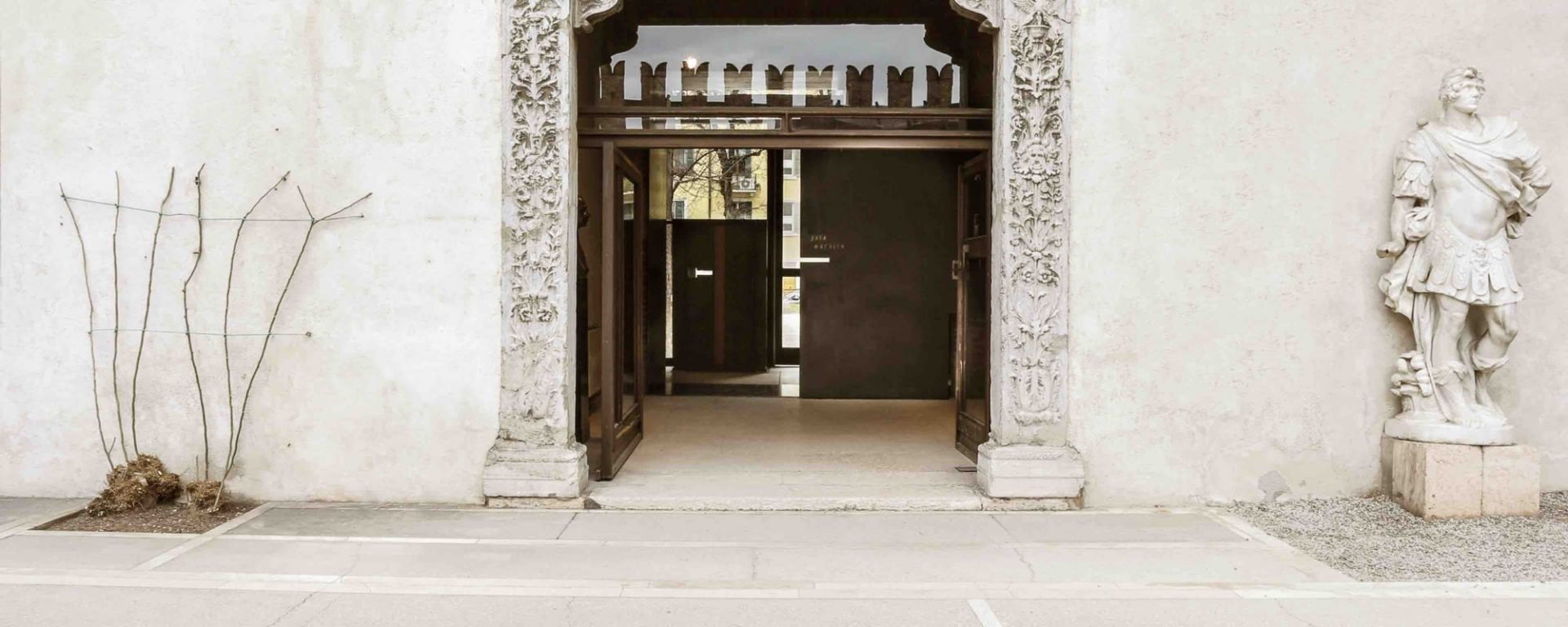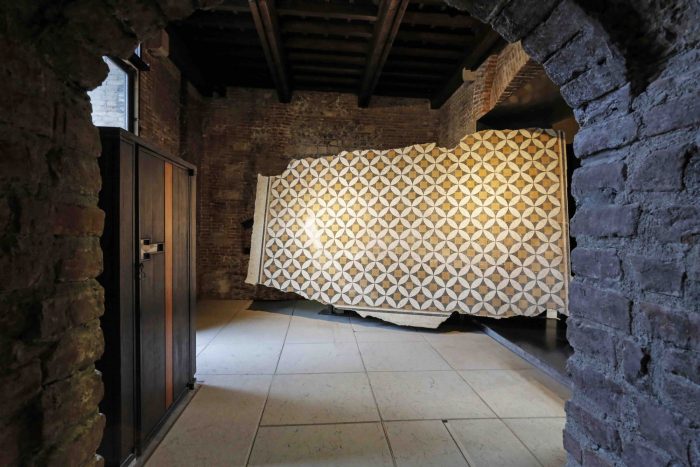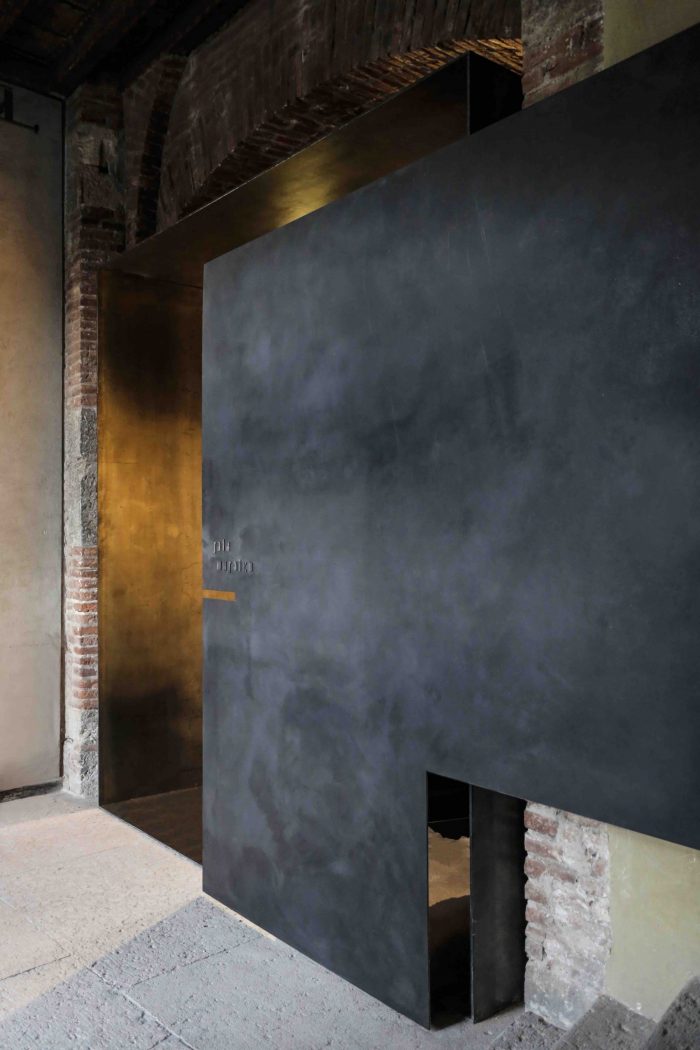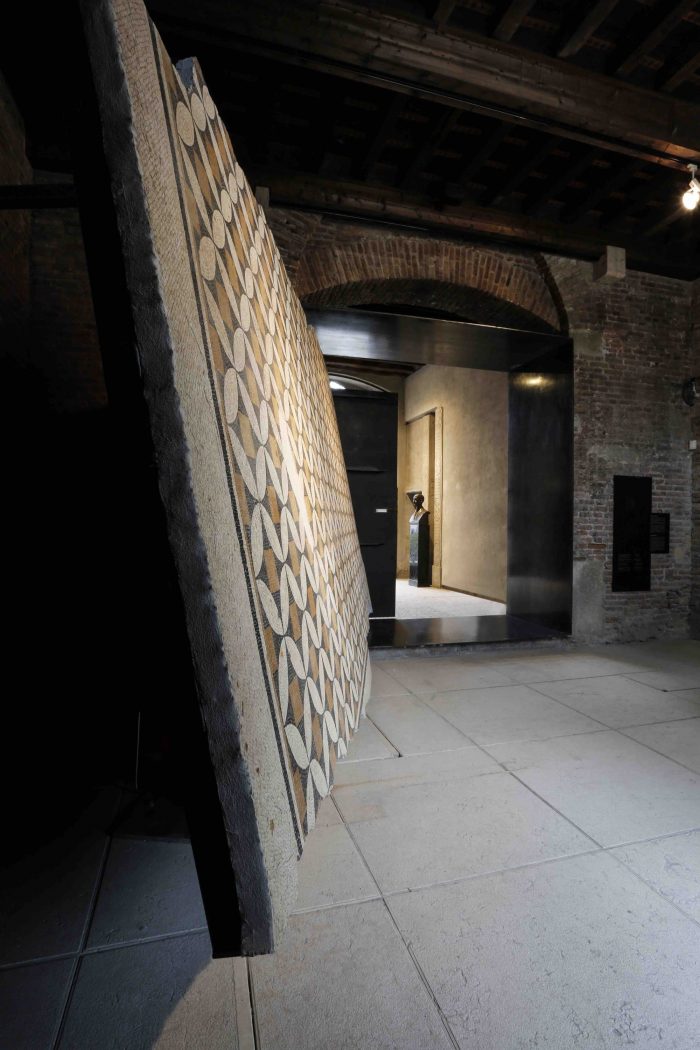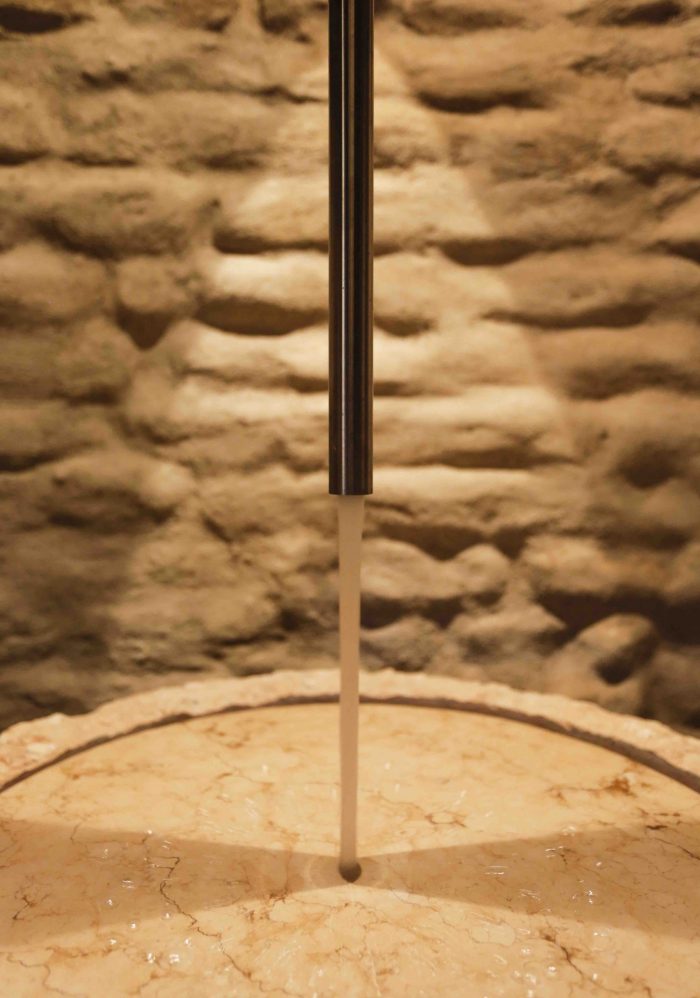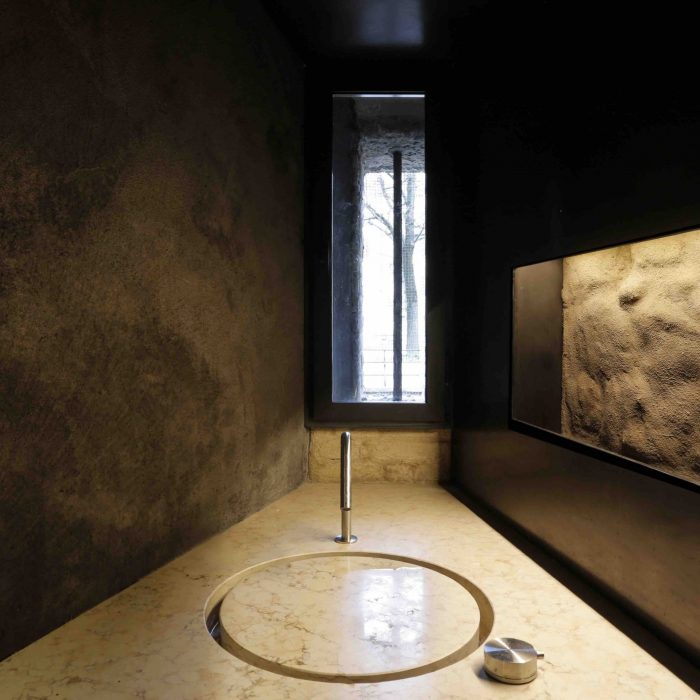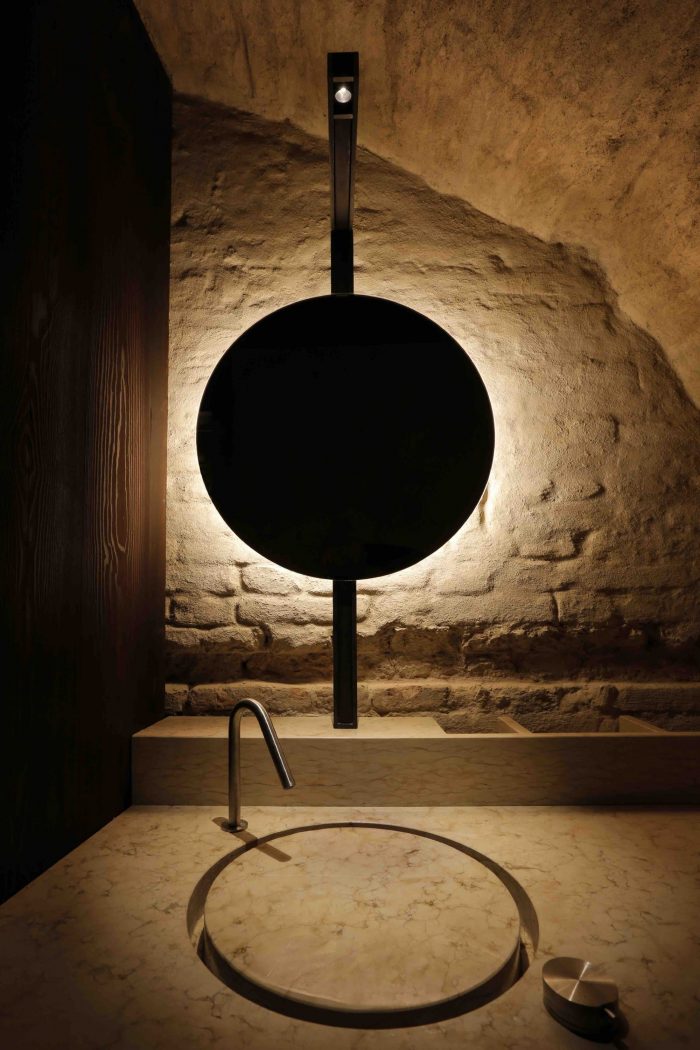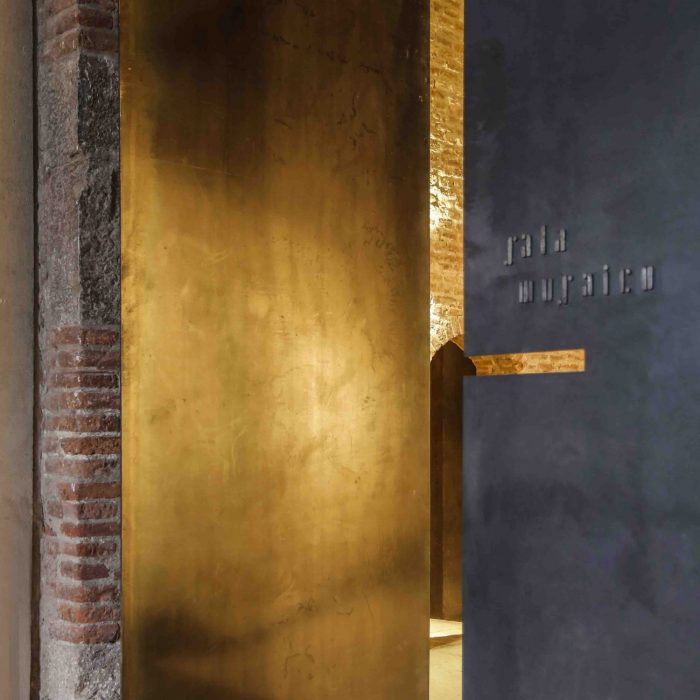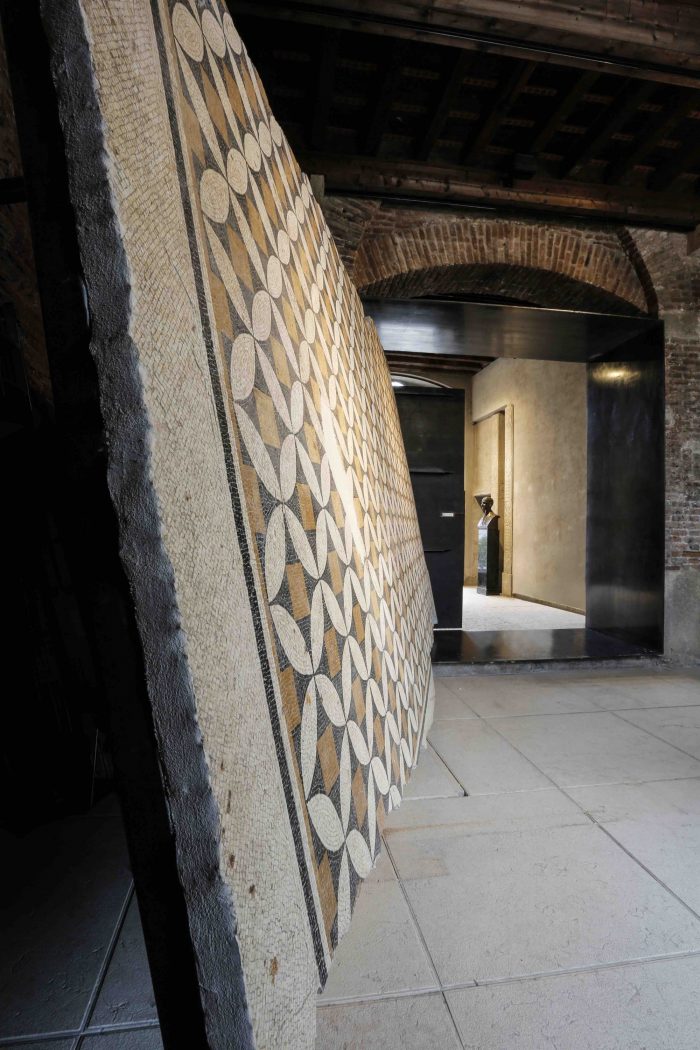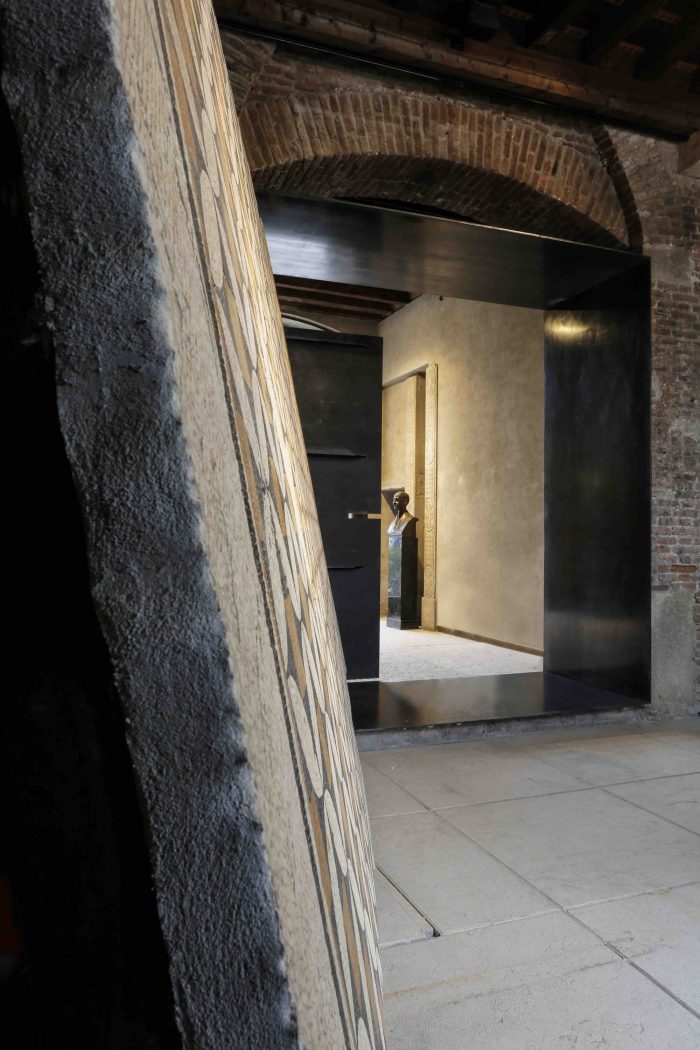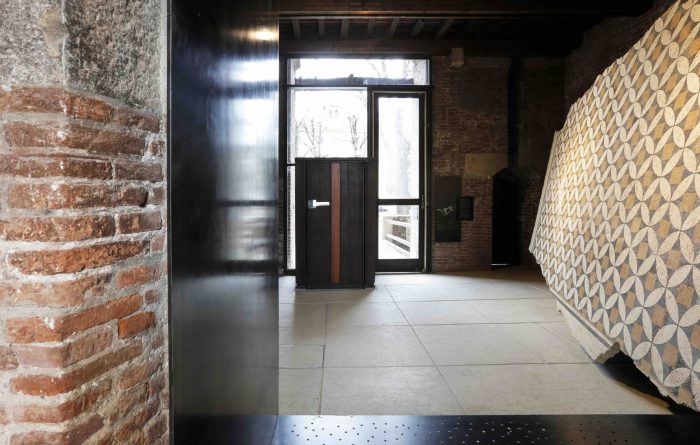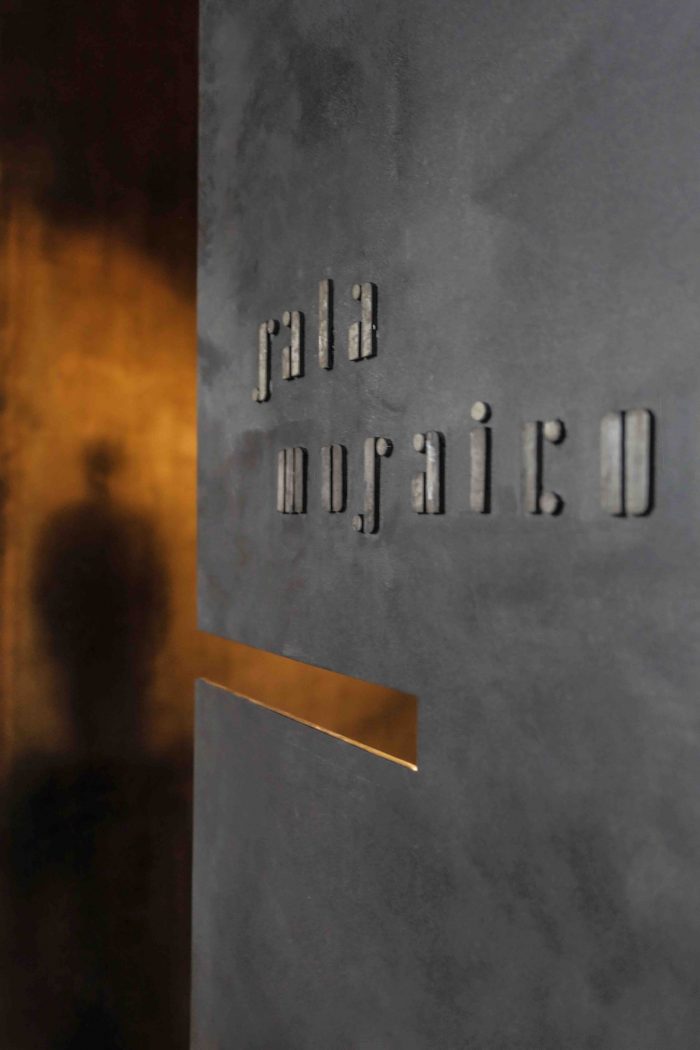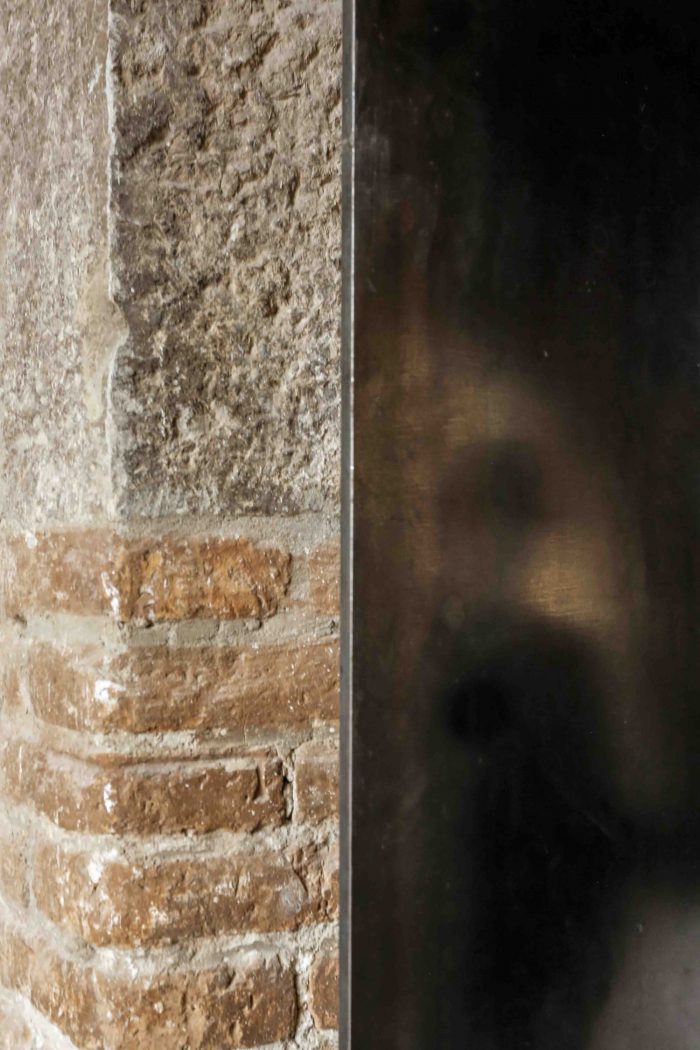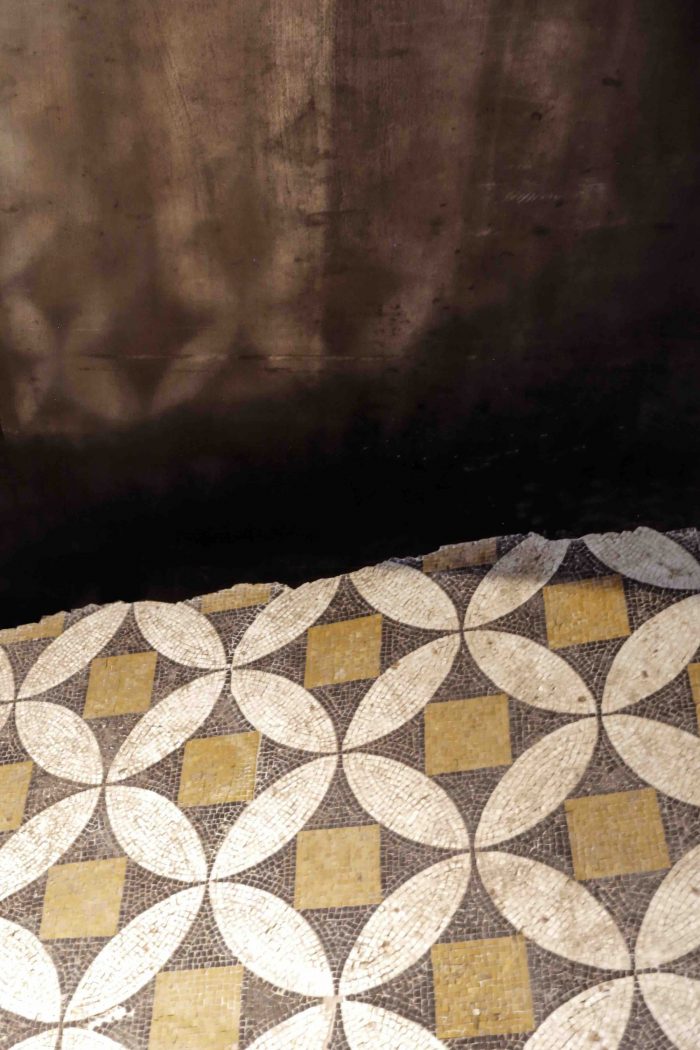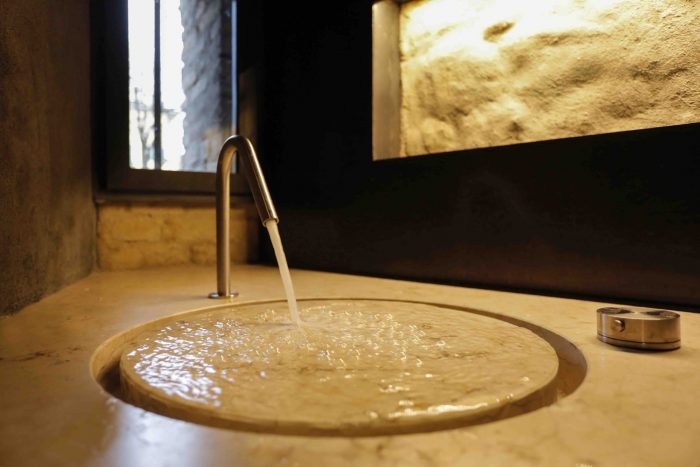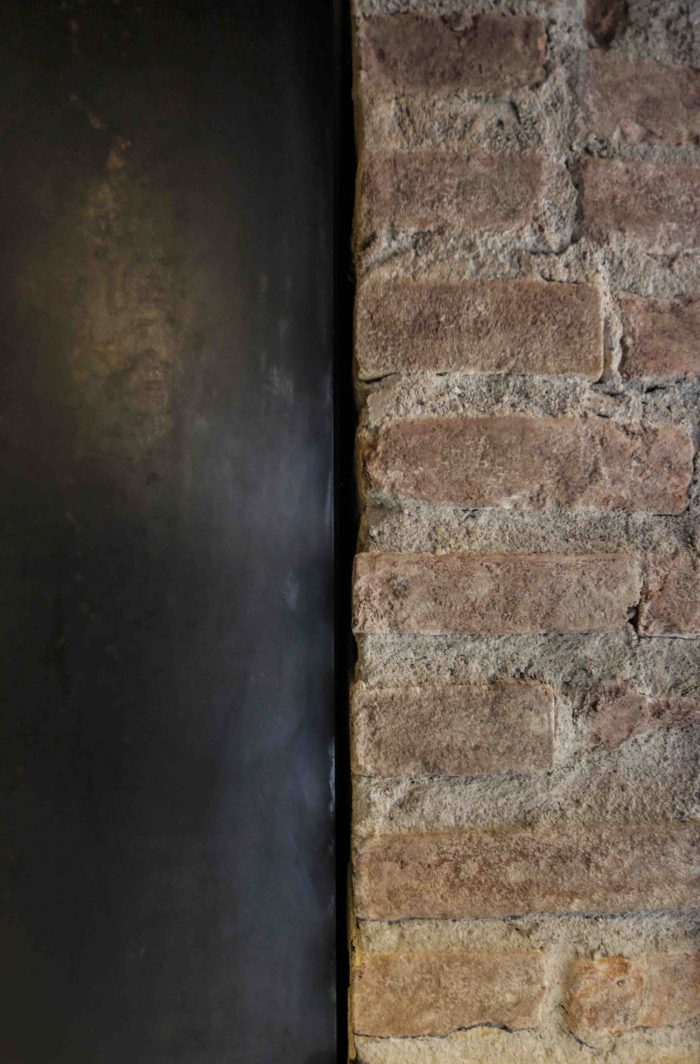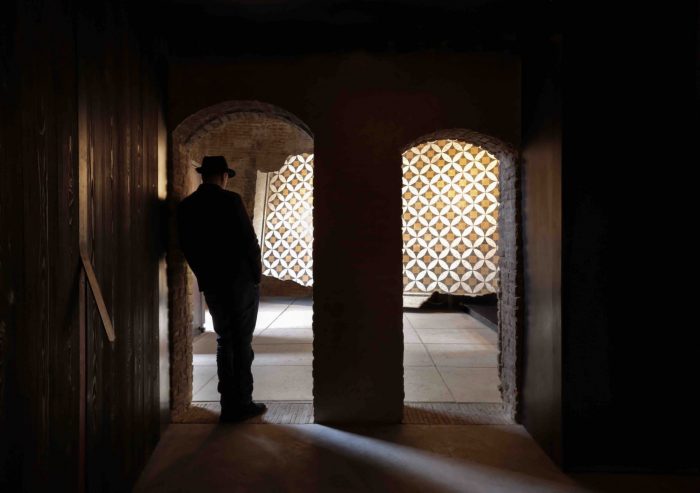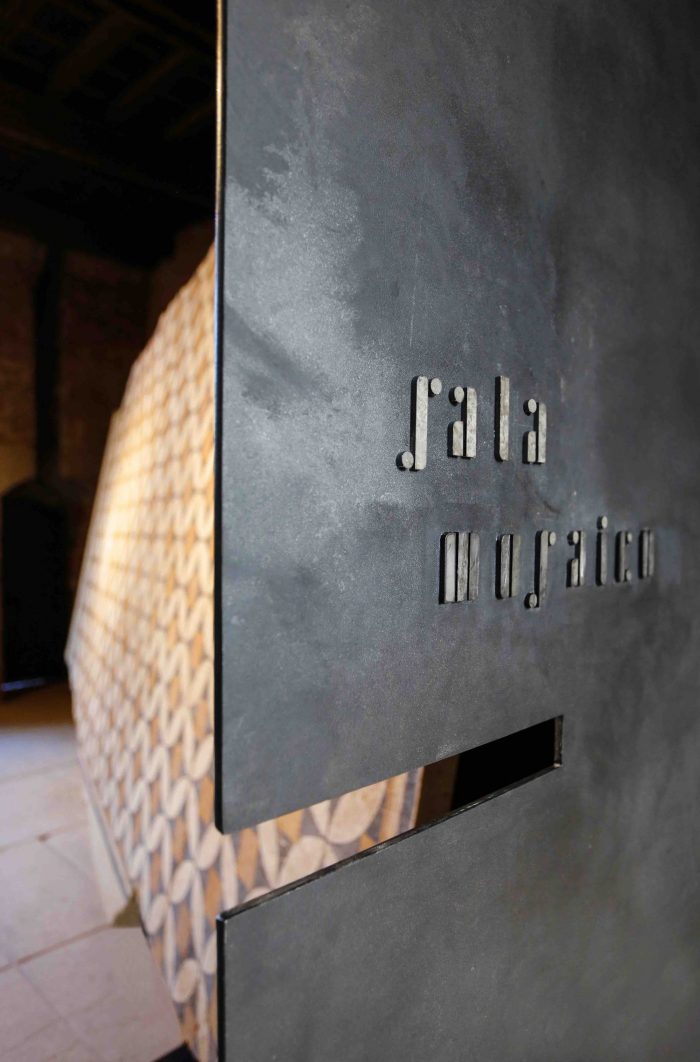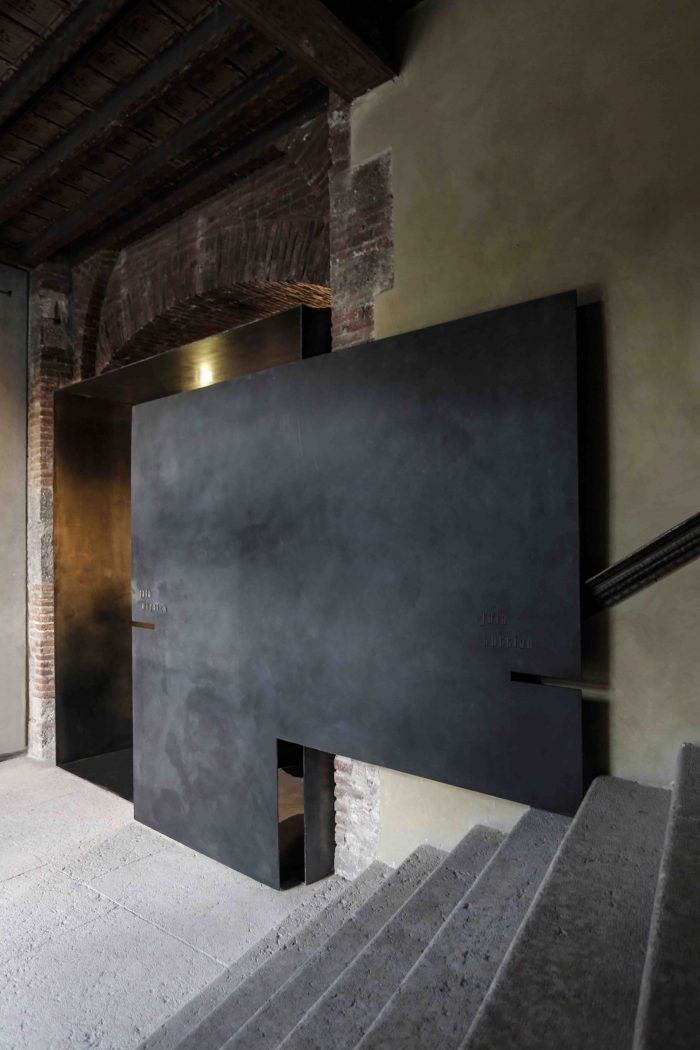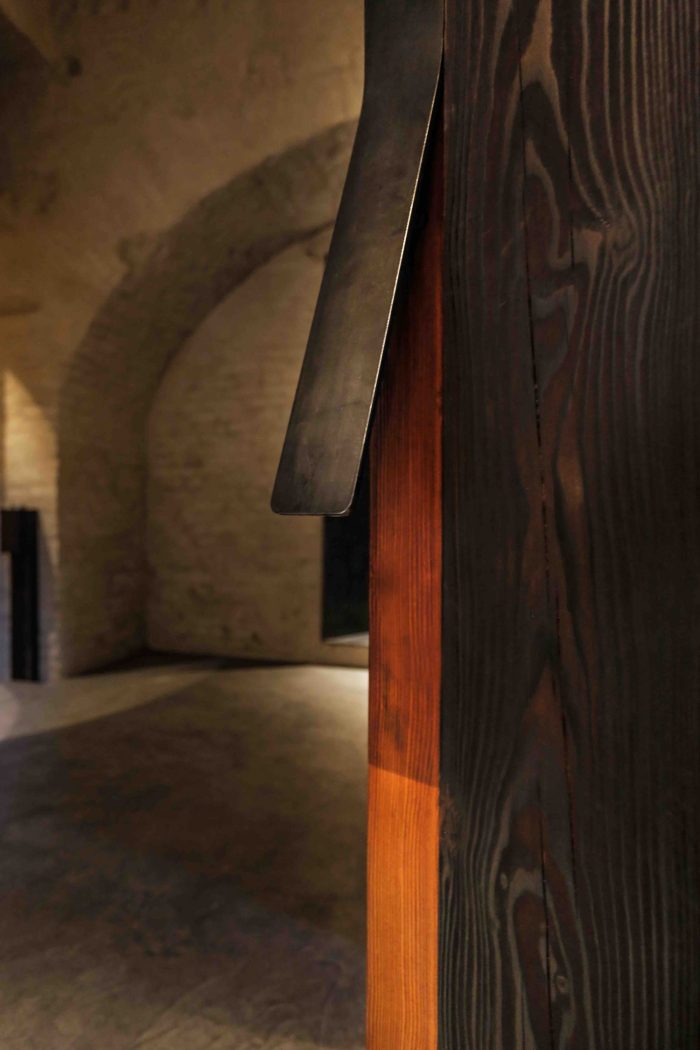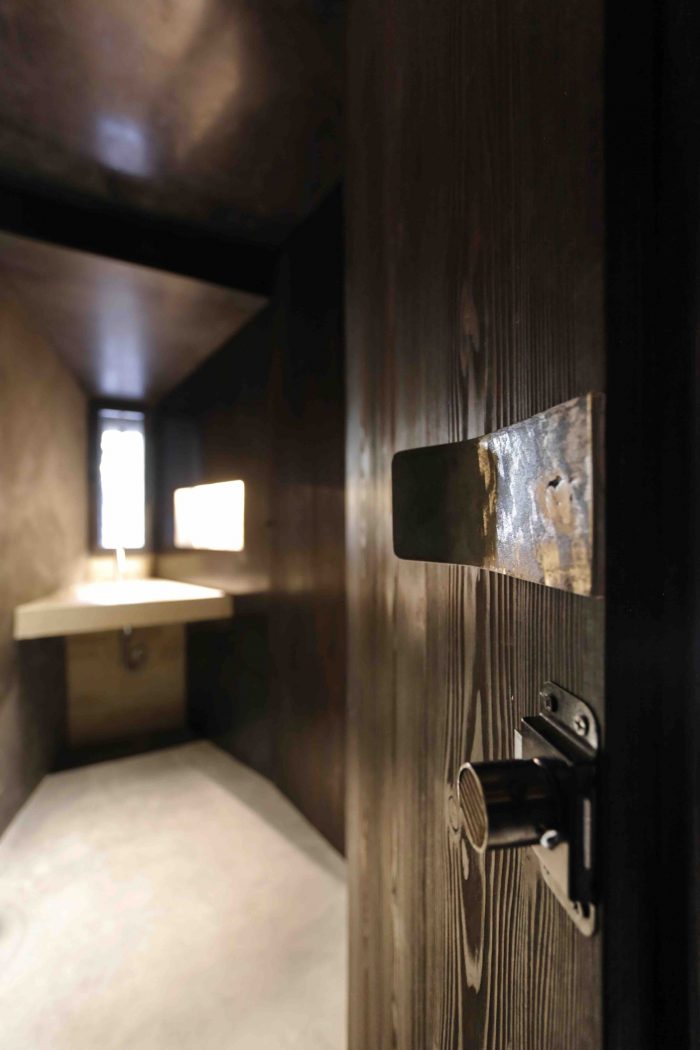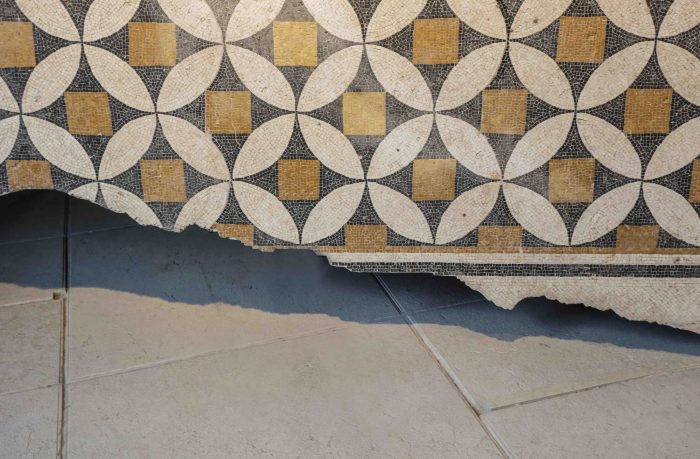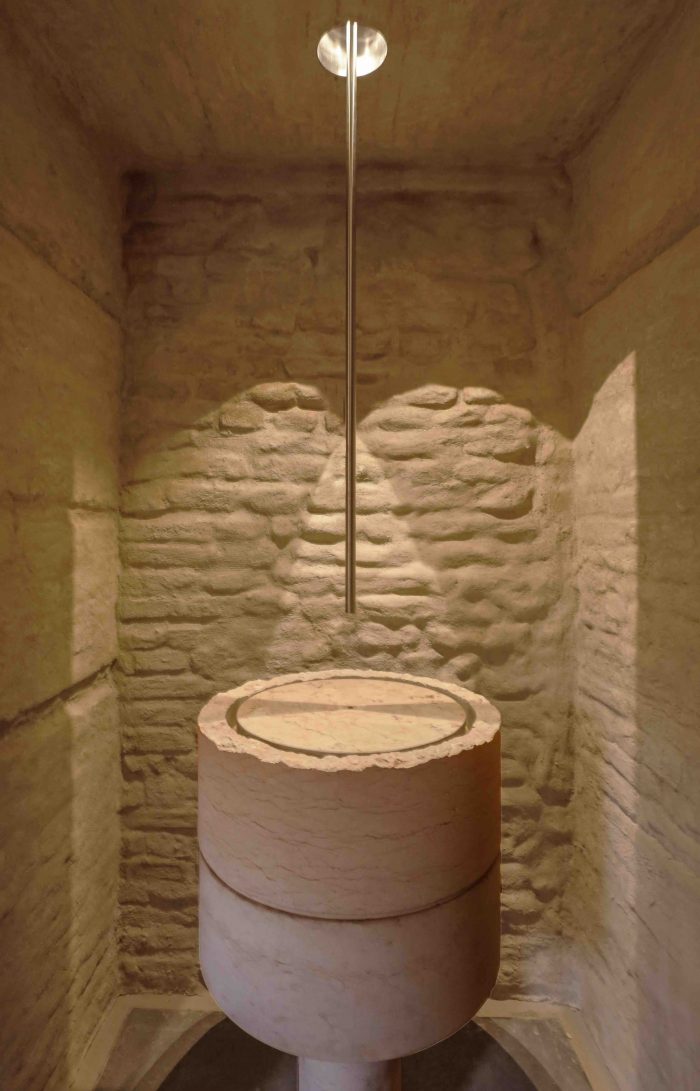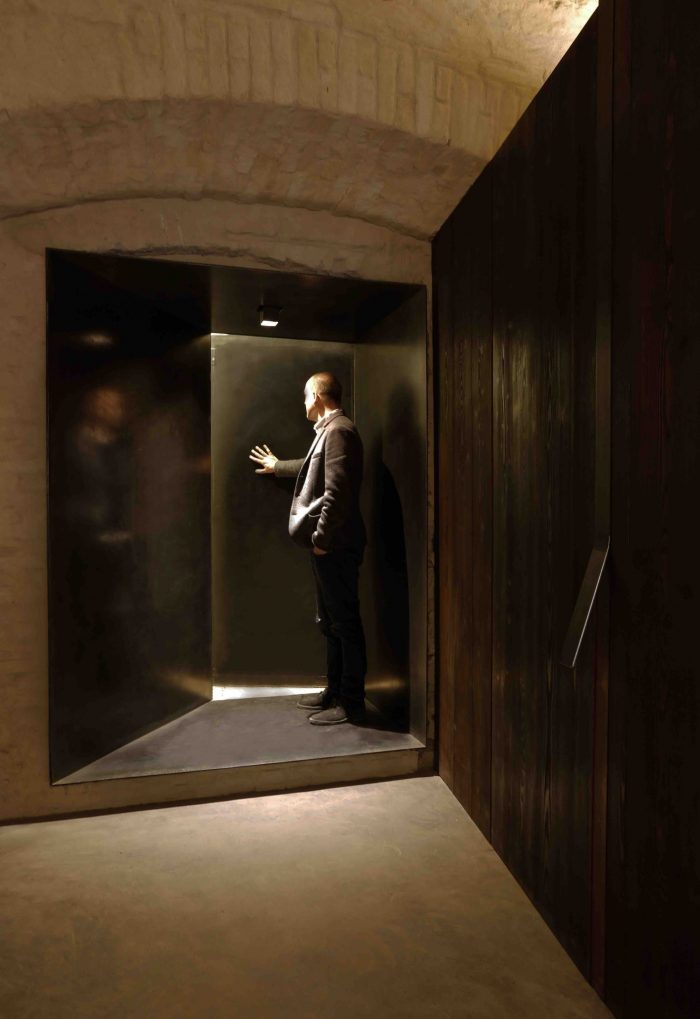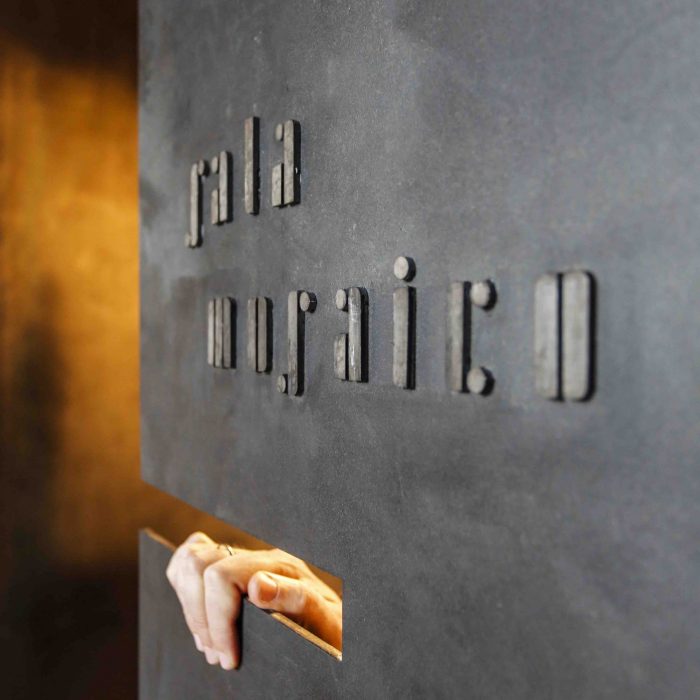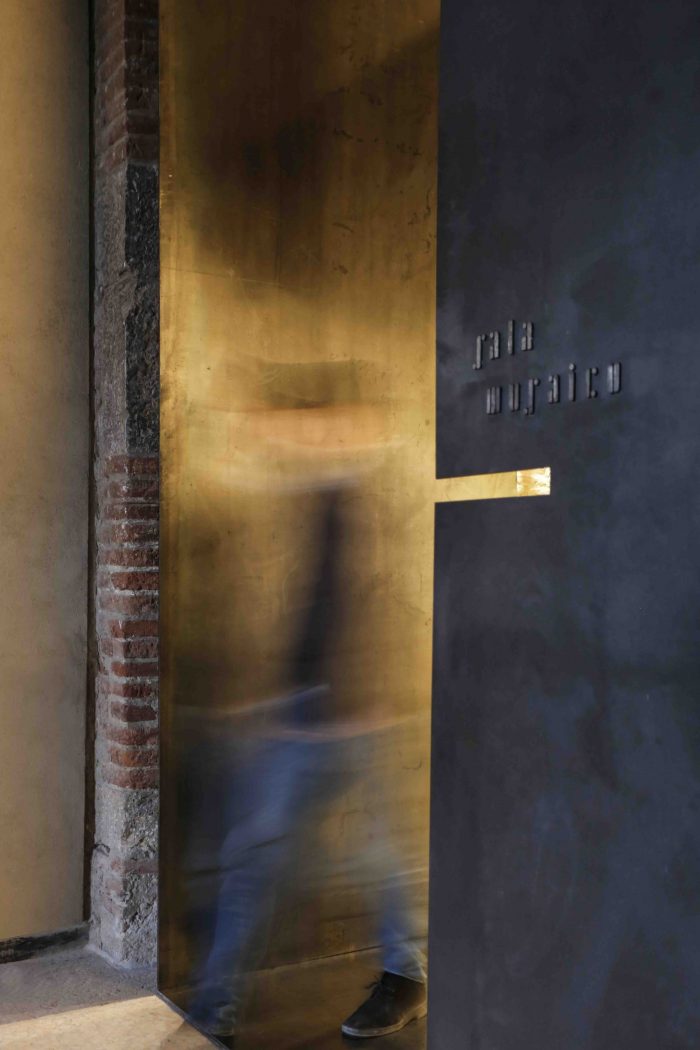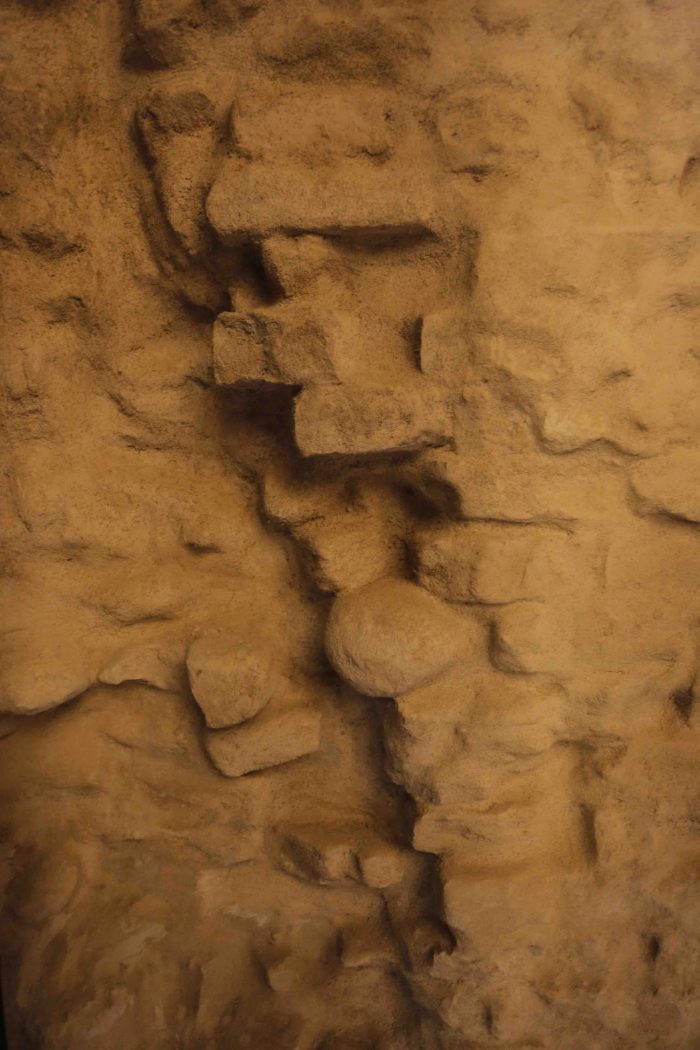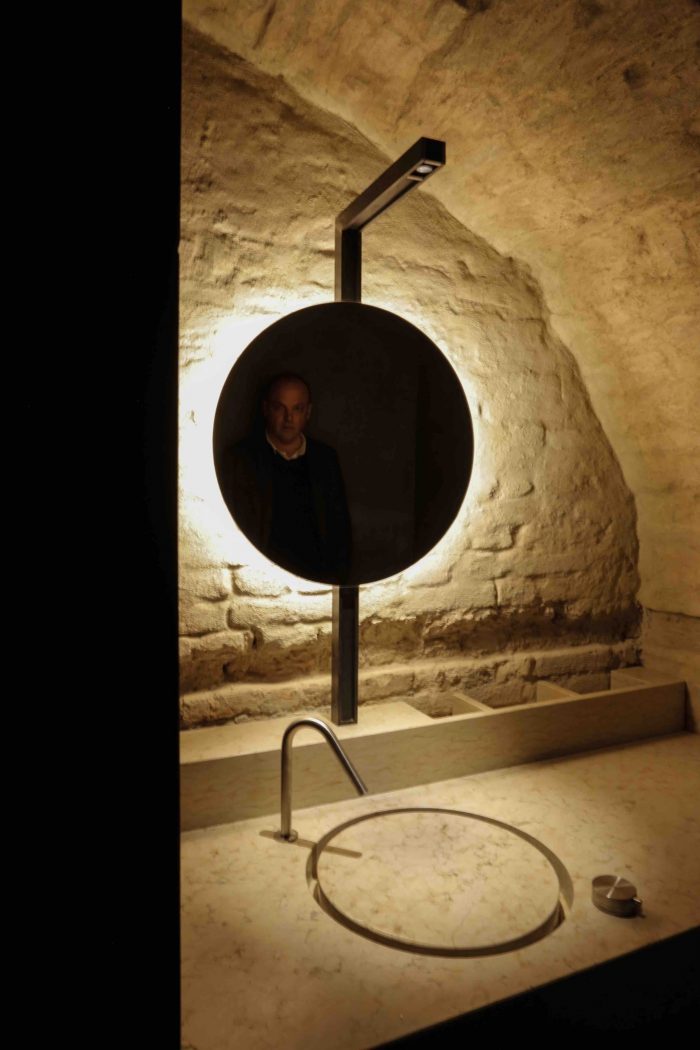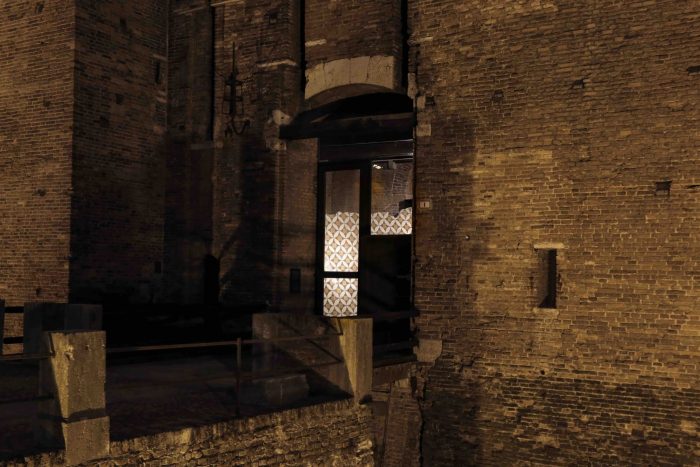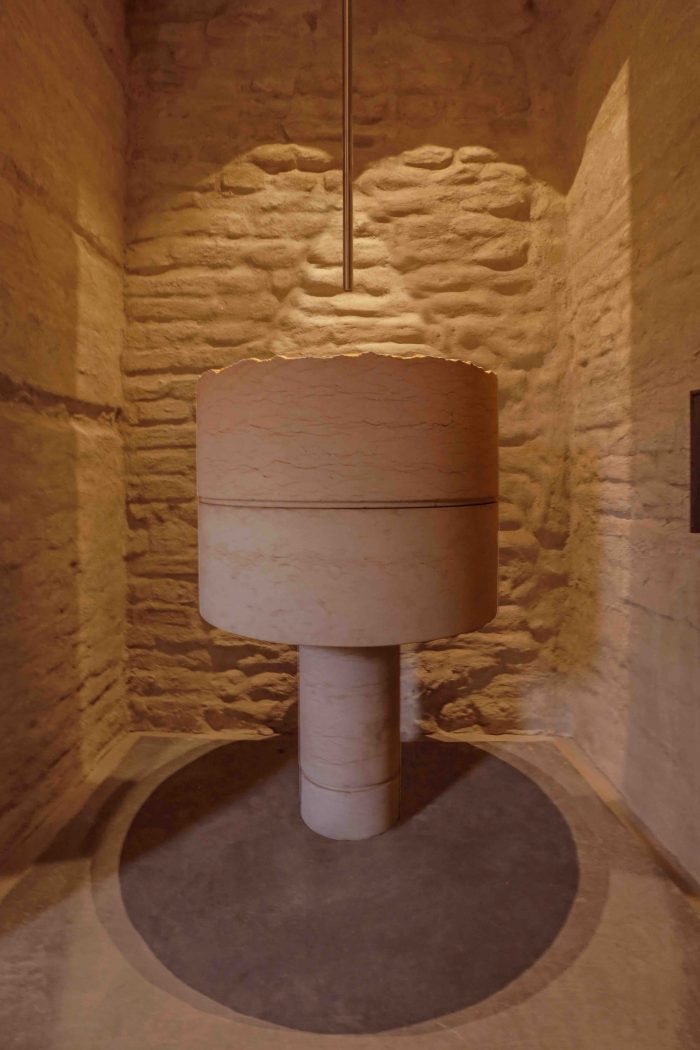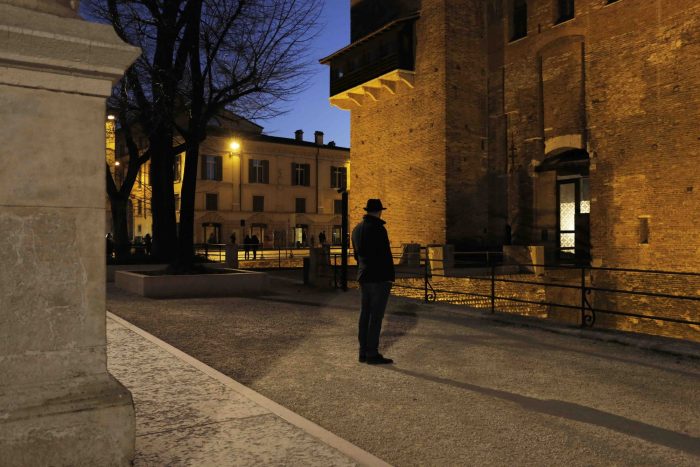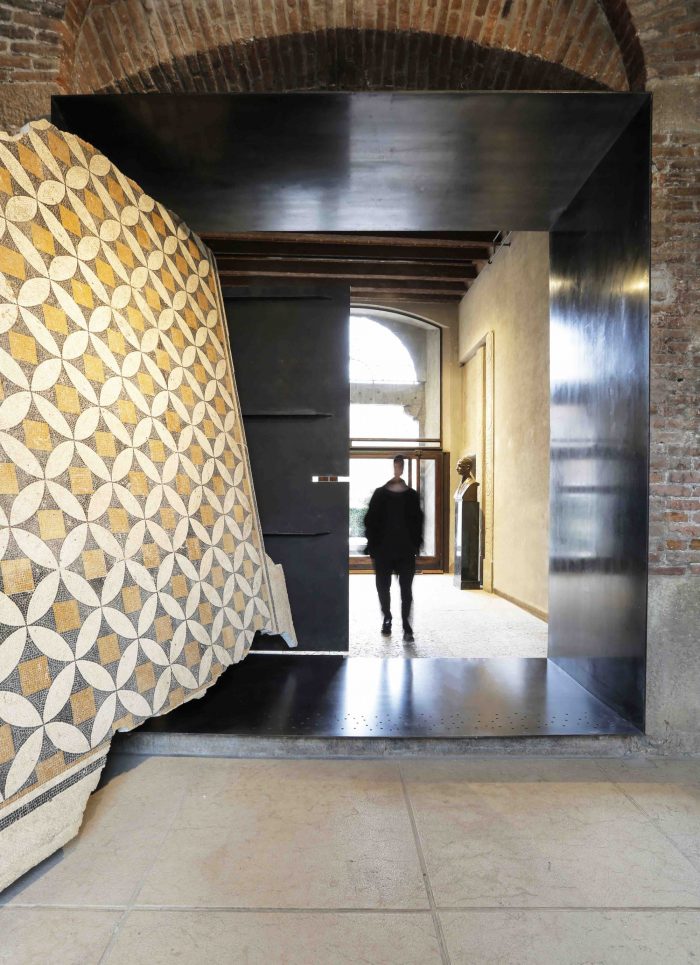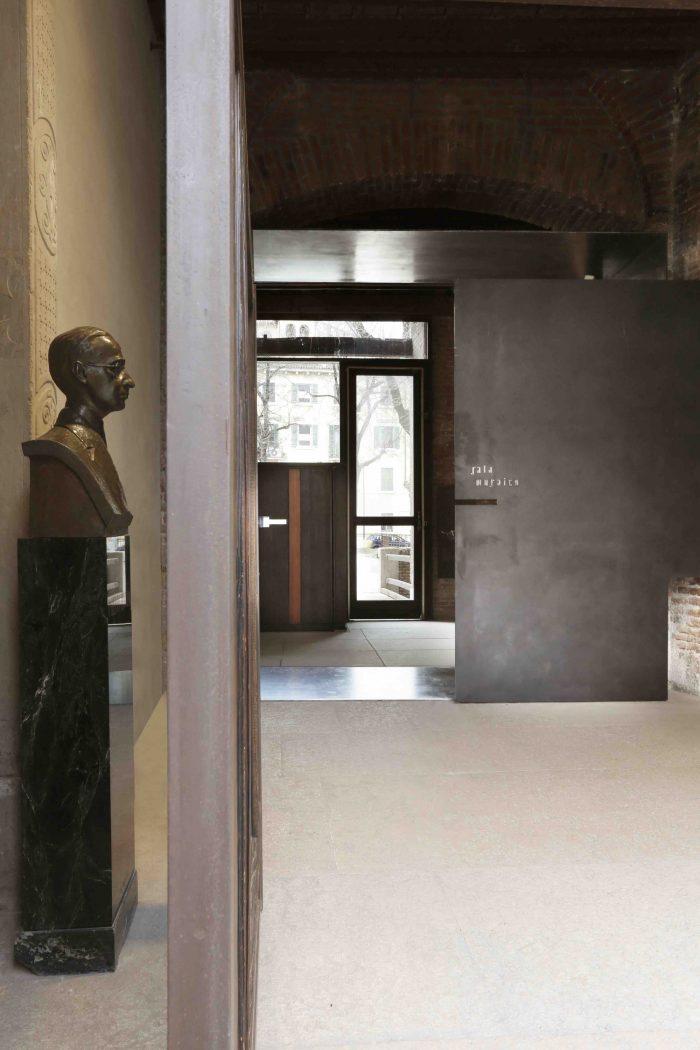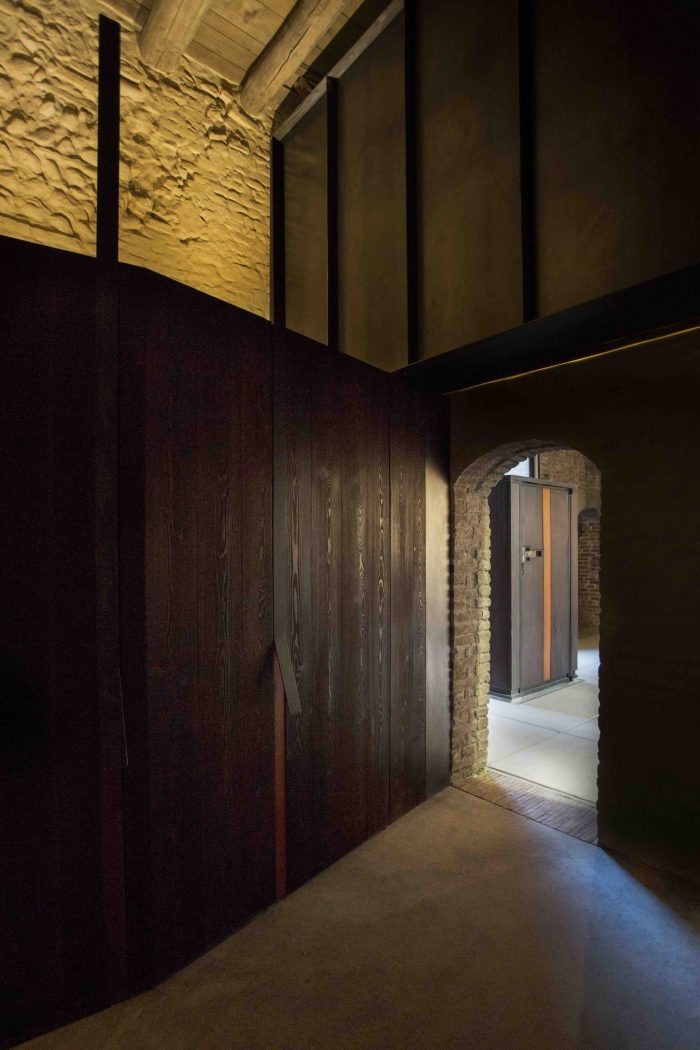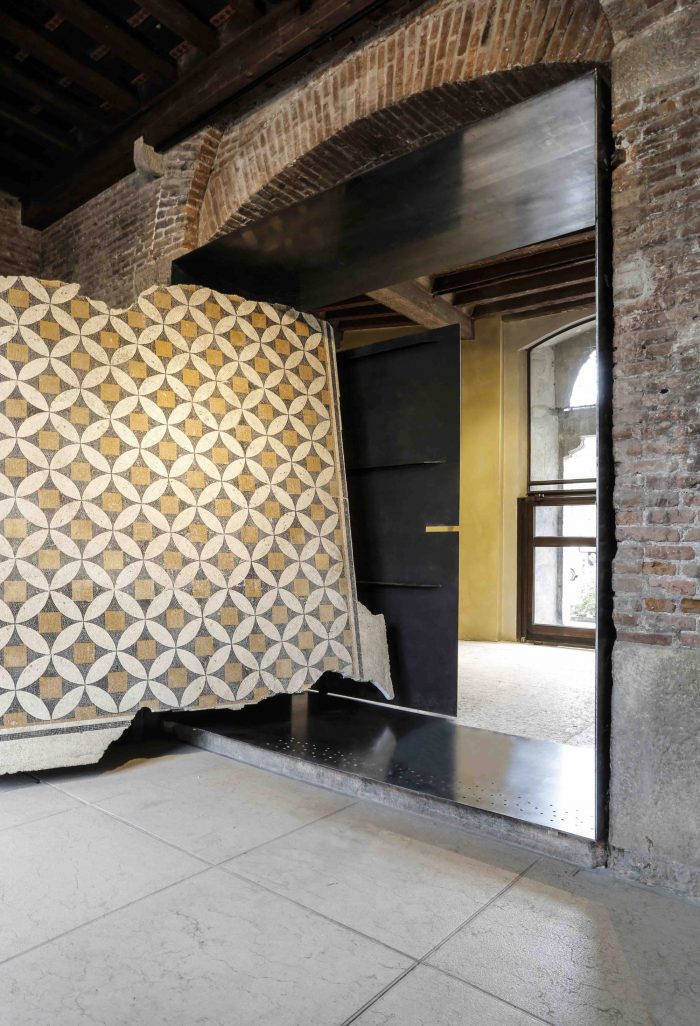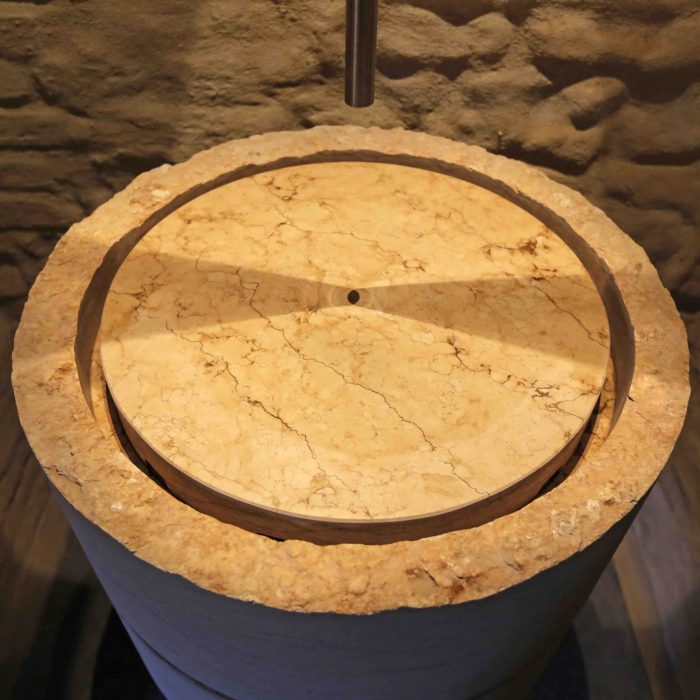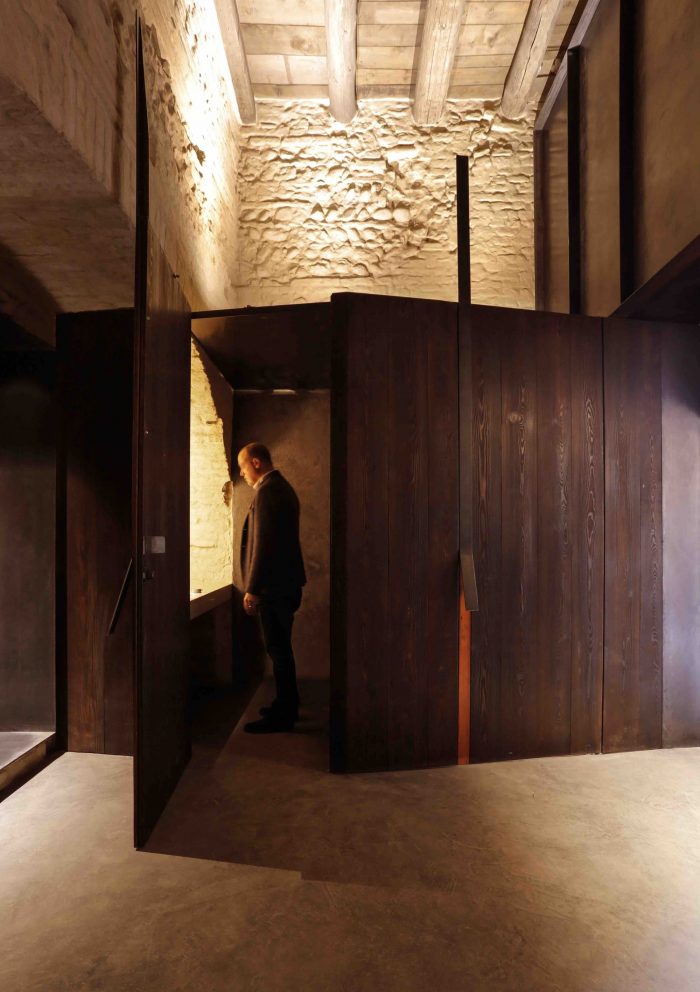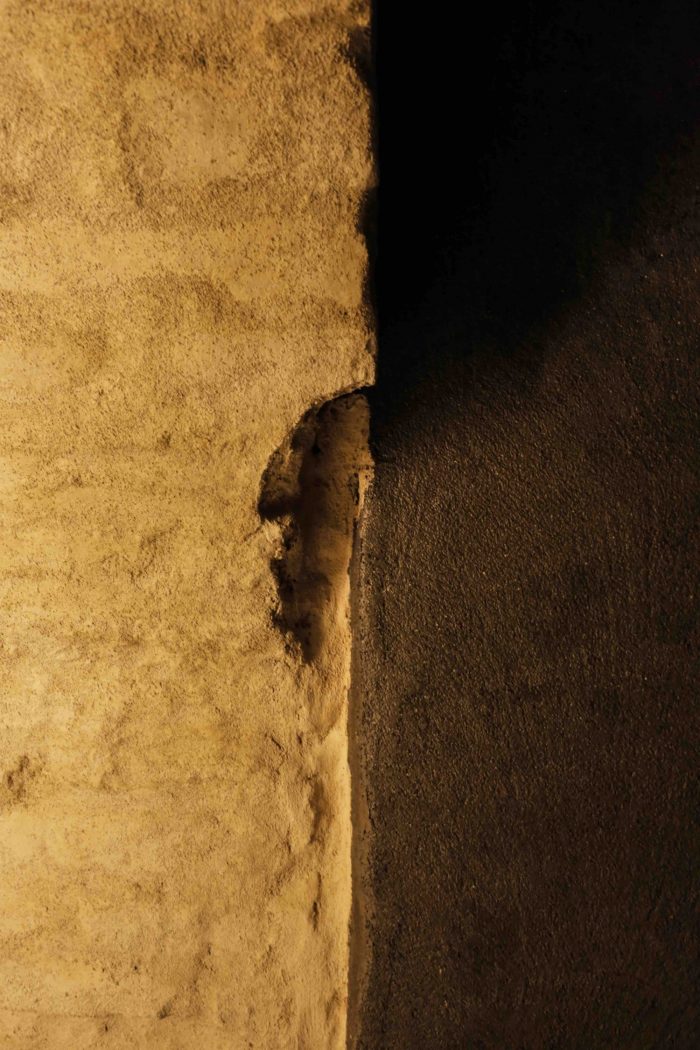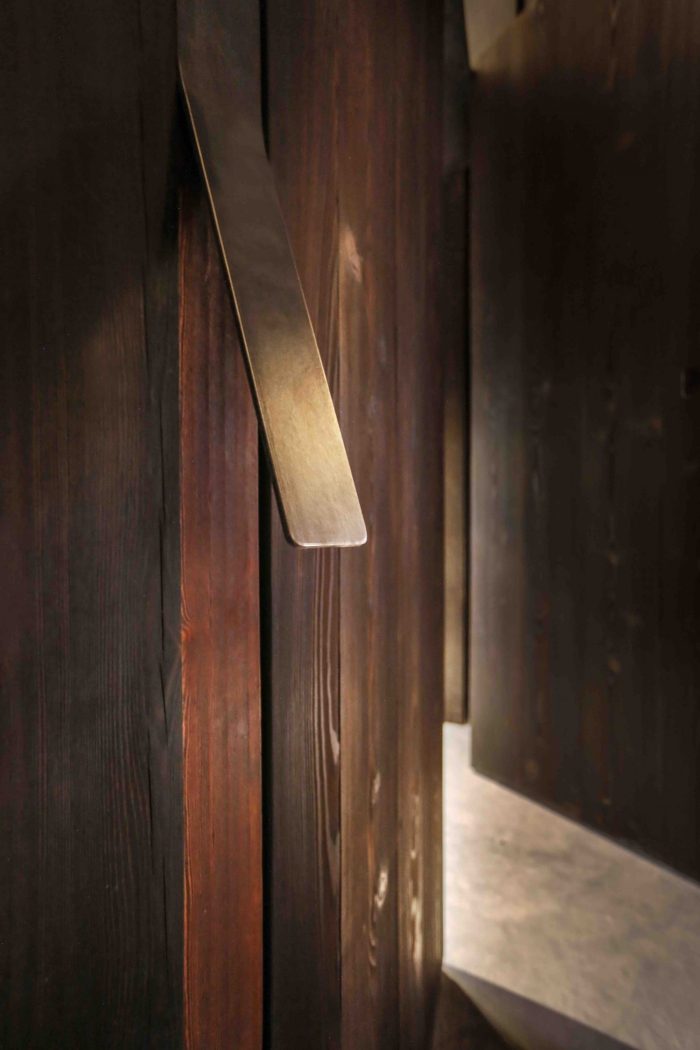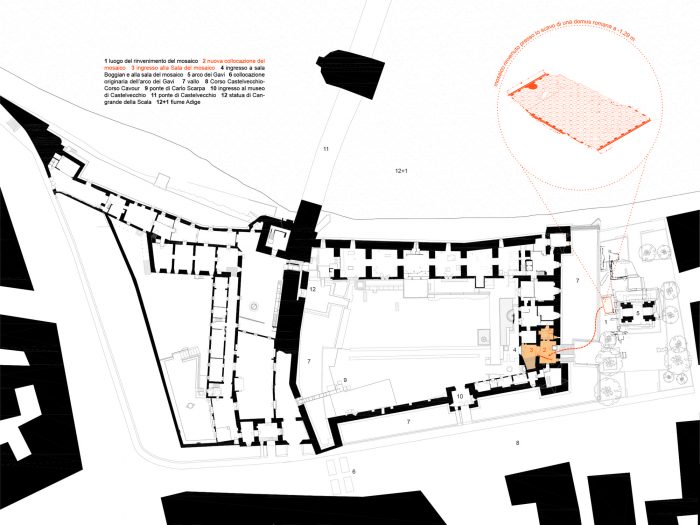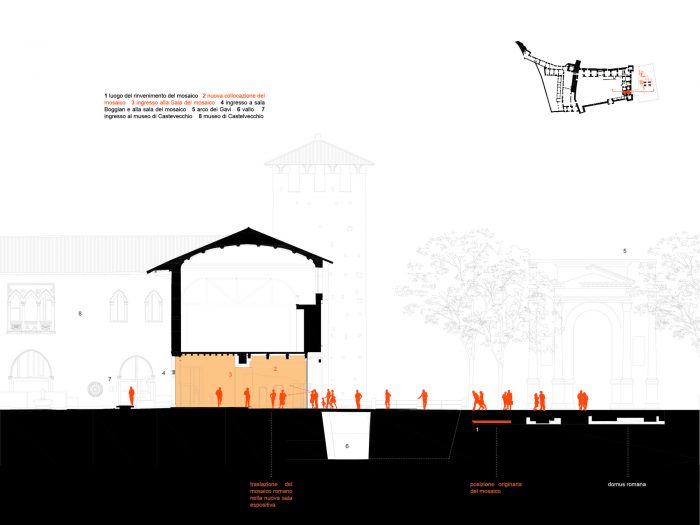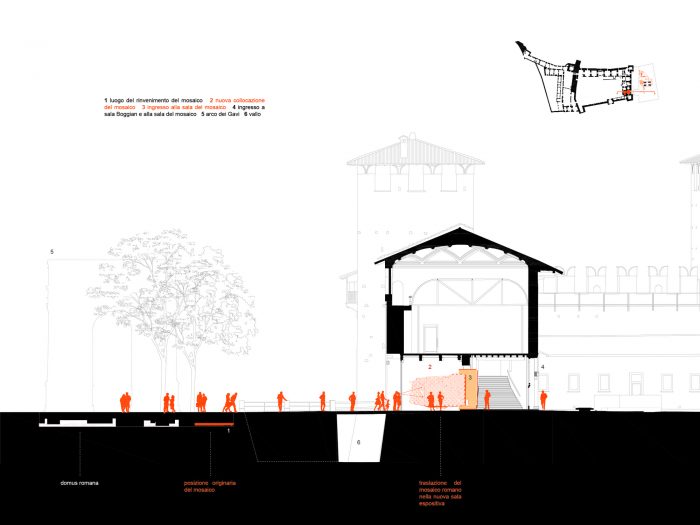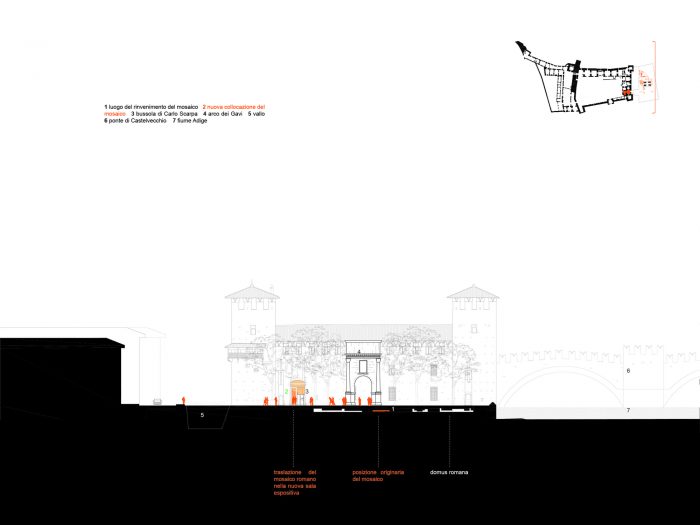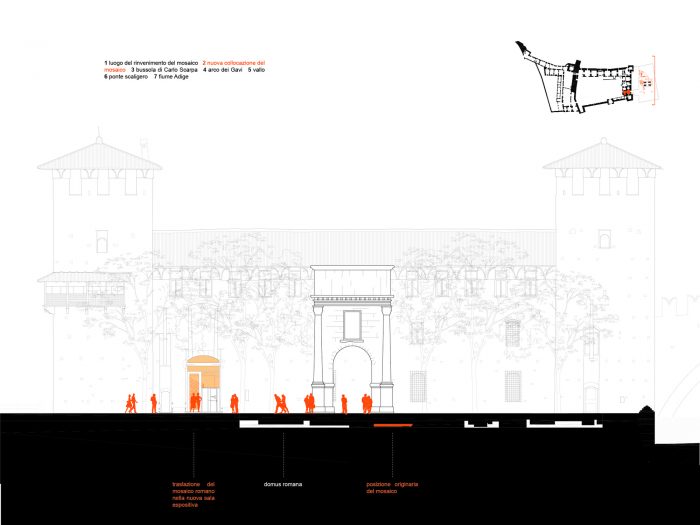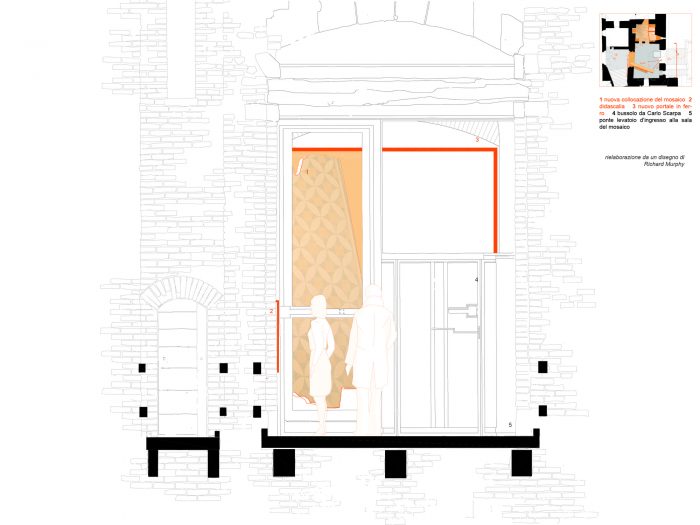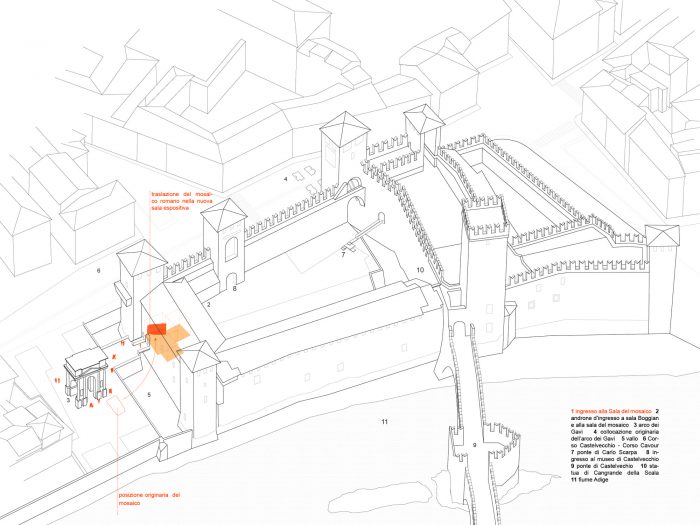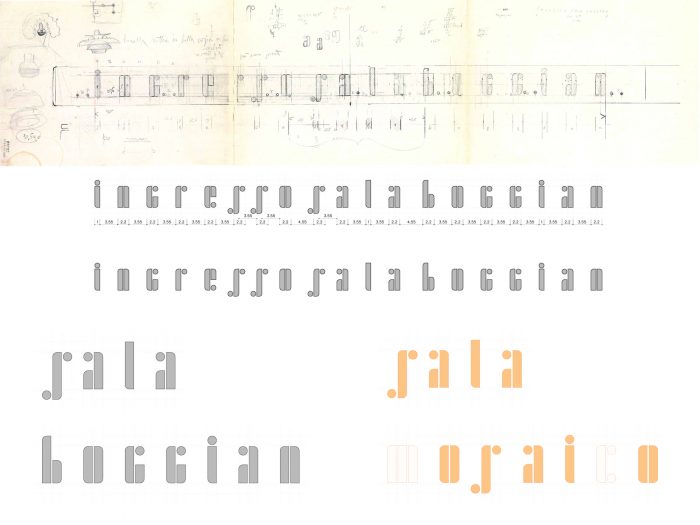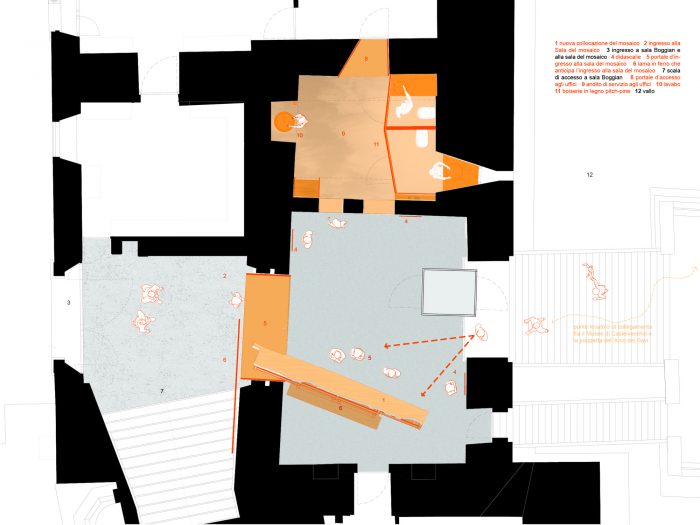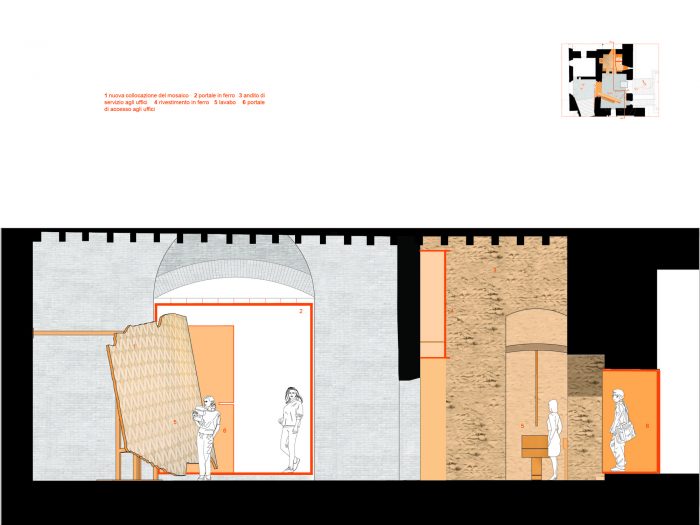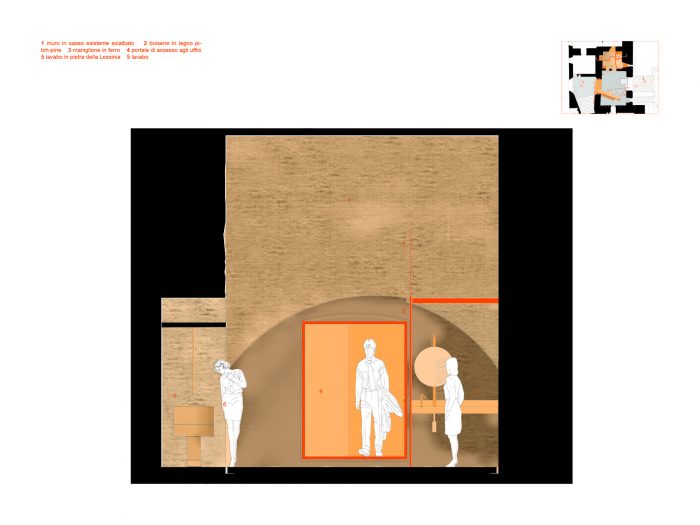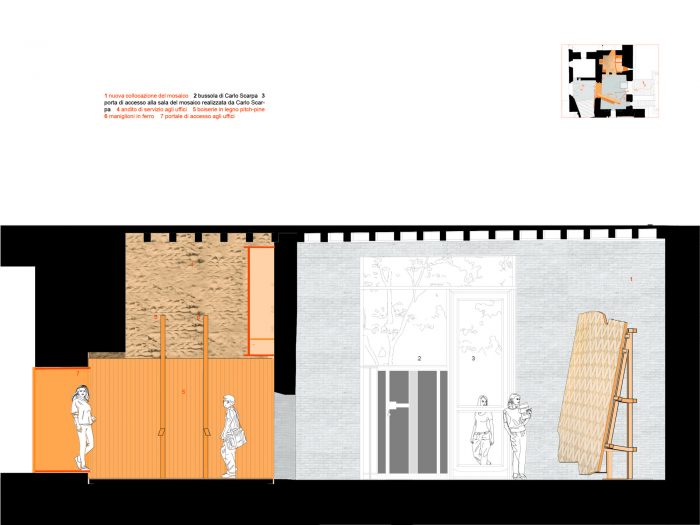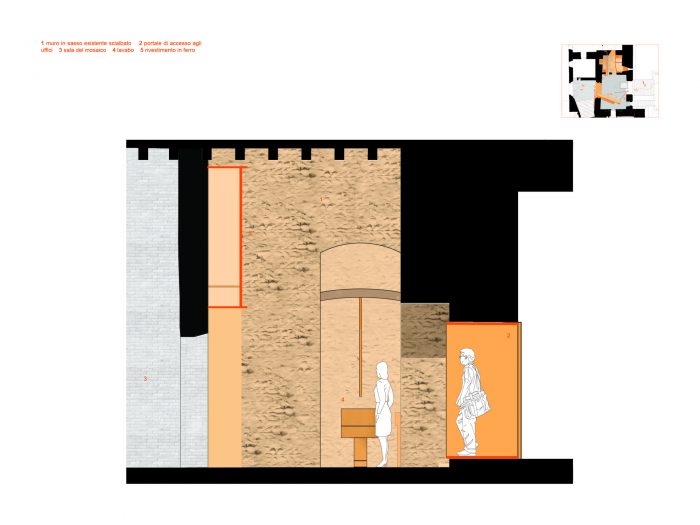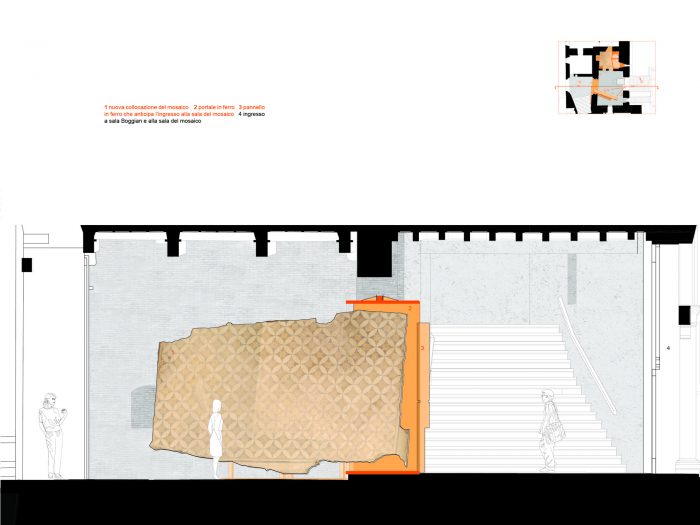Filippo Bricolo (Bricolo Falsarella Associates)为Castelvecchio博物馆设计的项目涉及东翼中央部分的修复,该部分在1964年Carlo Scarpa大师级的修复工程中未完成。干预措施的支点是新的马赛克厅,该厅被设计为放置一块来自公元二世纪domus的大型罗马路面碎片,该碎片是在位于城堡东侧的古Via Postumia和Adige河之间的小广场上发现的。
Filippo Bricolo’s project (Bricolo Falsarella Associates) for the Castelvecchio Museum regards the restoral of the central part of the East Wing which was left unfinished by Carlo Scarpa’s masterful restoration in 1964. The fulcrum of the intervention is the new Mosaic Room designed to host a large fragment of Roman pavement from a second century AD domus which was discovered in the little square located on the east side of the castle between the ancient Via Postumia and the River Adige.
新的展览厅通过一个高大的通道与城堡的主庭院相连,该通道也是Sala Boggian的入口。一块大而薄的铁板划定了走廊的双重性质:一方面,它作为通往新的马赛克房间的必要过滤器,另一方面,它指示了通往一楼房间的道路。
The new exhibition hall is connected to the main courtyard of the castle through a high access space that also serves as the entrance to Sala Boggian. A large and very thin iron panel delimits the dual nature of the hallway: on the one hand it acts as a necessary filter leading to the new Mosaic room and on the other hand, it indicates the way to the room on the first floor.
新的展览厅通过一个高大的通道空间与城堡的主庭院相连,这个通道也是通往Sala Boggian的入口。一块大而薄的铁板划定了走廊的双重性质:一方面,它作为一个必要的过滤器通往新的马赛克房间,另一方面,它指示了通往一楼房间的道路。
The new exhibition hall is connected to the main courtyard of the castle through a high access space that also serves as the entrance to Sala Boggian. A large and very thin iron panel delimits the dual nature of the hallway: on the one hand it acts as a necessary filter leading to the new Mosaic room and on the other hand, it indicates the way to the room on the first floor.
在关于面板的第二层,是一个由四个10毫米厚的黑色铁板形成的拱门。拱门的作用是确定进入马赛克房间的一个小仪式。这是必要的,以便在入口大厅和展览空间之间创造一个情感梯度。关于照明,拱门利用了黑铁的反射特性,在两个空间之间创造了对话。站在入口大厅里,拱门的可见面反射着马赛克厅的暖色灯光,将它们投向入口区。
On a second level regarding the panel, is an archway formed by four, 10 mm thick, black iron plates. The archway has the role of determining a small ritual of access to the Mosaic Room. This is necessary in order to create an emotional gradient between the entrance hall and the exhibition space. Regarding lighting, the archway makes use of black iron’s reflectance characteristics to create dialogue between the two spaces. Standing in the entrance hall, the visible side of the archway reflects the warm lights of the Mosaic Room casting them towards the entrance area .
铁还突出了一天中不同时间段的光线变化,直到它们被黄昏的来临意外地温暖起来。在马赛克厅,同样的垂直面将博物馆院子里的灯光和色彩反射到马赛克厅。这样一来,门洞就成了反射的铰链。这个新的门槛成为一个叙事装置,它分割但又统一,它揭示但又放慢,它创造距离但又邀请你走过去。
Iron also highlights the changing light at different times of day until they are unexpectedly warmed up by the onset of dusk. In the Mosaic Room, the same vertical side reflects the lights and colours of the museum’s courtyard into the Mosaic Room. In this way, the gateways becomes a hinge of reflections. This new threshold becomes a narrative device that divides but unites, that reveals but slows down, that creates distance but invites you to walk through.
在新的展览厅内,巨大的马赛克似乎悬浮在丰富的空间里。大厅的特点是由砖块制成的高墙。砖块被特意留了下来,没有改变或删除时间的斑驳。这有助于在墙壁和古罗马地板的物质性之间创造一种对话。
Inside the new exhibition hall, the great mosaic seems to levitate in the bountiful space. The hall is characterized by high walls made of brick. The bricks were deliberately left visible without changing or deleting the patina of time. This helps to create a dialogue between the walls and the materiality of the ancient Roman floor.
在新的展览厅内,巨大的马赛克似乎悬浮在丰富的空间中。大厅的特点是由砖块制成的高墙。砖块被特意留了下来,而没有改变或删除时间的斑纹。这有助于在墙壁和古罗马地板的物质性之间创造一种对话。
Inside the new exhibition hall, the great mosaic seems to levitate in the bountiful space. The hall is characterized by high walls made of brick. The bricks were deliberately left visible without changing or deleting the patina of time. This helps to create a dialogue between the walls and the materiality of the ancient Roman floor.
在新的展览厅内,巨大的马赛克似乎悬浮在丰富的空间中。大厅的特点是由砖块制成的高墙。砖块被特意留了下来,而没有改变或删除时间的斑纹。这有助于在墙壁和古罗马地板的物质性之间创造一种对话。
Inside the new exhibition hall, the great mosaic seems to levitate in the bountiful space. The hall is characterized by high walls made of brick. The bricks were deliberately left visible without changing or deleting the patina of time. This helps to create a dialogue between the walls and the materiality of the ancient Roman floor.
Architects: Filippo Bricolo & Bricolo Falsarella Associates
Area : 161 m²
Year : 2017
Photographs :atelier XYZ
Manufacturers : Ceadesign
Procedure Manager City Of Verona : Sergio Menon
Rup Associate – City Of Verona : Viviana Tagetto
Coordination Manager Of Museums And Monuments City Of Verona (Project Phase) : Paola Marini
Technical Department Manager For Exhibit Design Of Museums And Monuments : Alba Di Lieto
Coordination Manager Of Museums And Monuments (Implementation Phase) : Margherita Bolla
Structurale Advisor : Maurizio Cossato
Captions : Studio Bricolo Falsarella Associati, Ketty Bertolaso, Margherita Bolla
Architect In Charge : Filippo Bricolo
Project Team : Francesca Falsarella, Simone Sala, Elisa Bettinazzi, Giacomo Scabbio
Structural Advisor : Maurizio Cossato
City : Verona
Country : Italy

